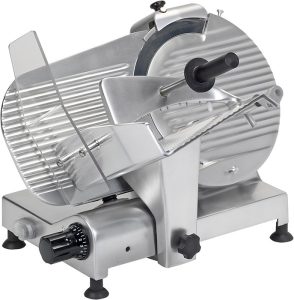Professional Meat Slicer: A Buying Guide for Models and Types
Among the most appreciated food products are cured meats and sausages, which vary by region. From Prosciutto di Parma to Salsiccia di Norcia, from Bresaola della Valtellina to Capocollo di Martina Franca, these foods are generally served to the consumer as slices. The precision of the cut is often underestimated, yet it is crucial. A professional meat slicer is also specific for slicing bread, meat, fish and vegetables, making the quality of the machine essential to avoid damaging the product.

Types of Professional Meat Slicers: Electric or Manual?
When precise, uniform, and quick cuts are required, one cannot rely solely on manual skill, making high-quality professional slicers necessary.
These machines vary in type, diameter, power, precision, and safety. Each of these parameters is equally important as they affect not only the quality of the cut but also the safety of the operator and the integrity of the product.
So, how do you choose a good professional meat slicer?
The first factor to consider is the blade diameter, which is crucial as smaller formats are suited for slicing smaller-sized cured meats. Power, measured in watts, is also essential, as it determines the blade’s rotation speed; the higher the revolutions per second, the better the precision of the cut.
Electric slicers are the most common for these and other reasons, but the demand for manual slicers is also growing. Let’s look at the differences.
Manual Professional Meat Slicer: Elegant and Stylish
This model not only boasts an elegant vintage design but is also characterized by the absence of electrical components. In short, the blade is operated manually by turning a side crank, and its rotation speed depends on the speed of the arm’s rotary movement. The manual slicer is undeniably more charming and captures the allure of a bygone era, but it also requires good manual skill.
In delicatessens, where there is a constant flow of customers, a quick service is required, which a manual slicer cannot meet. However, in other settings, like wine bars, where the pace can be more relaxed, this equipment would perform its role perfectly, besides being an aesthetically pleasing object that stands out.
Electric Professional Meat Slicers: Versatile and Practical
Conversely, electric slicers operate on electricity. Much more practical and versatile, this type of slicer, even if not excellent in design, is the ideal solution for most industry activities. Therefore, the choice between the two models depends solely on usage needs. Both types can further be divided into two groups:
- Vertical slicers
- Gravity slicers
The difference is immediately noticeable in the shape. Vertical slicers have the blade perpendicular to the plane, while gravity slicers have a blade inclination of less than 90°. Vertical slicers are particularly recommended for cutting meat, while many restaurateurs prefer the second type for cured meats, cheeses, vegetables, and bread because it facilitates the downward fall of the slice.
Elements to Consider Before Purchasing
After choosing the type of slicer, what elements should be examined to ensure the purchase of quality and safe equipment?
Blade Quality and Stability Support
A quality blade must be thick steel, forged, tempered, and chrome-plated to achieve precise millimeter cuts. The aluminum support ensures the blade’s stability, keeping it aligned even during intensive use, preventing dangerous oscillating movements.
Machine Body Material and Ease of Disassembly and Reassembly
The machine body must meet certain construction material and ease of cleaning parameters. The material used is usually aluminum or, alternatively, specific alloys with anodic oxidation are used, which provide anti-wear and durability. To eliminate food residues that nest between the blade and the machine body, thorough cleaning with specific, non-contaminating detergents is necessary. Disassembly and reassembly of the components must therefore be simple and quick.
Motor Power
Motor power is crucial for a professional slicer to ensure the machine can operate uniformly and continuously for many hours. Even for domestic use, a power greater than 200 watts is recommended.
Cutting Adjustment
Another aspect that determines the choice of a professional slicer is the cutting thickness, which must be adjustable at various levels to achieve the ideal thickness depending on the product.
For professional use, the choice of slicers must be careful and precise. For over 30 years, Cook-In has been selling professional equipment for catering businesses and can provide you with all the useful information and advice for a safe and guaranteed purchase of the best products in terms of quality and price.



